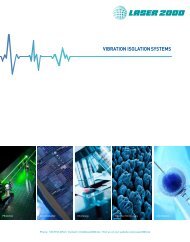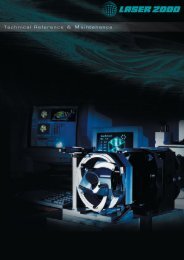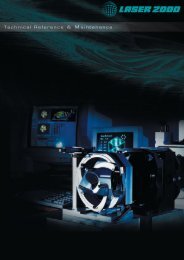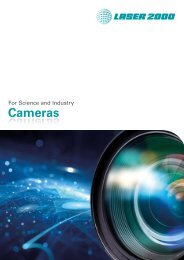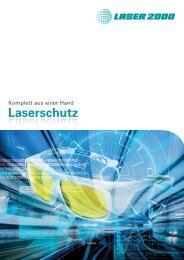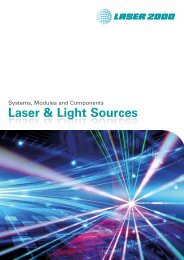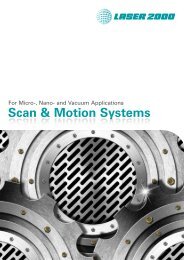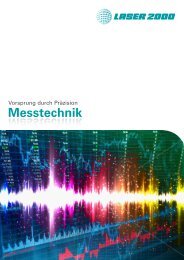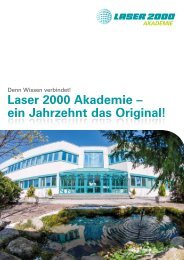Semrock Master Catalog 2018
Semrock Master Catalog 2018
Semrock Master Catalog 2018
Create successful ePaper yourself
Turn your PDF publications into a flip-book with our unique Google optimized e-Paper software.
BrightLine ® Laser Fluorescence Filters<br />
TECHNICAL NOTE<br />
Optical Filters for Laser-based TIRF & Super-resolution Microscopes<br />
The advent of lasers as light sources for TIRF & Super-resolution imaging imposes specific constraints on imaging systems and<br />
their components. For example, optical filters used in laser-based imaging systems have specific requirements that are unique<br />
compared to those filters used in broadband light source based instruments.<br />
Despite varying opinions, optical source clean-up filters (excitation filters) are important for laser sources to block the unwanted<br />
light at wavelengths away from the actual laser line, including spontaneous emission observed in solid-state lasers and the<br />
plasma lines of gas lasers. Additionally, these filters should be durable enough to withstand the high intensity of laser beams.<br />
Unlike the traditional soft-coated fluorescence filters used for decades, newer hard-coated thin-film filters made with ion-beam<br />
sputtering have high laser damage threshold (LDT) ratings. High optical durability, combined with the robust environmental<br />
reliability of hard-coated filters—which are virtually impervious to thermal and humidity induced degradation—eliminates the<br />
need to ever replace the filters for most fluorescence microscopy applications.<br />
Excitation filters for laser applications also have unique wavelength requirements. Some<br />
lasers, like gas lasers and DPSS lasers, have very precise and narrow laser lines. However,<br />
selection of a narrow laser line cleanup filter is not a good match for systems that might<br />
use multiple lasers with similar wavelengths (such as 473 nm and 488 nm for exciting<br />
GFP). The spectral output from diode and optically pumped semiconductor lasers can<br />
vary appreciably from laser to laser, with temperature, and as the lasers age. Therefore for<br />
most laser microscopy systems broader excitation filters that appear similar to those used<br />
for broadband light source (e.g., arc lamp) microscopy systems are a good solution. For<br />
example, the UV excitation band of the <strong>Semrock</strong> laser quad-band set is designed to be<br />
used with both 375 and 405 nm lasers, with the long-wavelength edge taking into account<br />
a ± 5 nm uncertainty in the wavelength of the 405 nm laser.<br />
A typical emission filter should provide high blocking (> OD 6) at all possible laser lines<br />
that might be used with the filter set, thus ensuring the darkest background signal level,<br />
while at the same time providing excellent transmission of the emission signal. It should be<br />
noted that not all emission filters for broadband light sources provide sufficient blocking at<br />
laser lines and therefore they can lead to an appreciable compromise in imaging contrast.<br />
Dichroics for laser applications should not only be made such that their reflection and transmission bands are compatible<br />
with the excitation and emission filters, but they also need to be coated with antireflection coatings in order to maximize<br />
transmission of the emission signal and eliminate coherent interference artifacts. Since the dichroic beamsplitter is directly<br />
exposed to the powerful excitation beam, even weak autofluorescence from<br />
the filter will contaminate the emission signal. Therefore, a substrate with ultralow<br />
autofluorescence, such as fused silica, should be used.<br />
LF405/488/561/635-B<br />
100<br />
The dichroic beamsplitter can have a significant impact on the image quality in<br />
certain applications, especially if the flatness (or curvature) of the dichroic is<br />
not suitable. For most laser microscope applications, the dichroic should<br />
be flat enough such that there is no noticeable shift in the focal spot of the<br />
illumination laser beam, where focal shift is typically defined by the Rayleigh<br />
range. This is critical for applications such as TIRF Confocal, PALM, STORM,<br />
SIM, and other super-resolution techniques.<br />
Demanding applications such as imaging of single molecules using TIRF may<br />
impose unprecedented constraints on the blocking of laser beams in the<br />
emission channel while maximizing the collection of every possible photon<br />
10<br />
0<br />
350 400 450 500 550 600 650 700 750<br />
from the fluorophores. In such situations, conventional bandpass emission<br />
Wavelength (nm)<br />
filters may be replaced by a long-wave-pass filter keyed to the specific laser<br />
line. In our observation, TIRF systems even benefit from using a second emission filter in conjunction with all the filters of a laser<br />
set. The main purpose of the second filter, which should be physically separated from the first emission filter, is to ensure that<br />
higher-angle scattered excitation light does not make it through the entire imaging path to the detector.<br />
Finally, conventional microscopy cubes can significantly compromise the flatness of the dichroic beamsplitters thereby<br />
introducing aberrations. But TIRF & super-resolution imaging systems are highly sensitive to optical wavefront distortion and<br />
demand the highest quality components for best instrument sensitivity. Our industry-leading TIRF & Super-resolution Microscopy<br />
Cubes that are guaranteed to provide 1λ P-V RWE are optimized for such high-end applications.<br />
Overall, the designs of the excitation and emission filters as well as that of the dichroic beamsplitter should be complementary<br />
to each other to obtain the highest fidelity fluorescence visualization. Optical filters play a vital role in obtaining maximum<br />
performance from complex, expensive, laser-based microscopes and it only makes sense to invest in optical filters that match<br />
the performance of the imaging system.<br />
Transmission (%)<br />
90<br />
80<br />
70<br />
60<br />
50<br />
40<br />
30<br />
20<br />
Sample<br />
Cover<br />
Glass<br />
Dichroic<br />
Beamsplitter<br />
Evanescent Light<br />
Oil<br />
Objective<br />
Excitation Filter<br />
Emission Filter<br />
Fluorophores<br />
Single-band<br />
Sets<br />
Multiband<br />
Sets<br />
Cubes<br />
Laser<br />
Sets<br />
NLO<br />
Filters<br />
Individual<br />
Filters<br />
Dichroic<br />
Beamsplitters<br />
Tunable<br />
Filters<br />
41<br />
More



